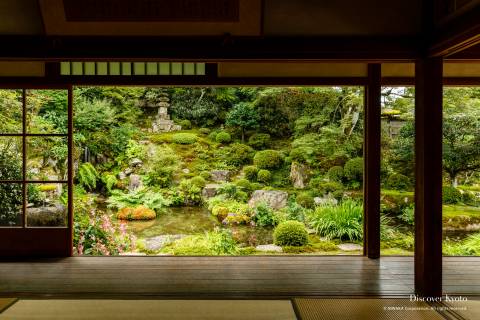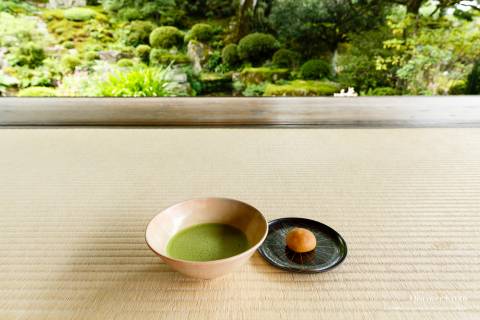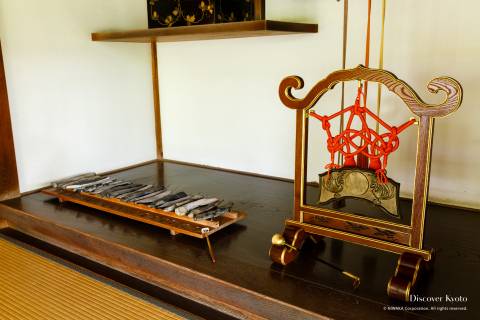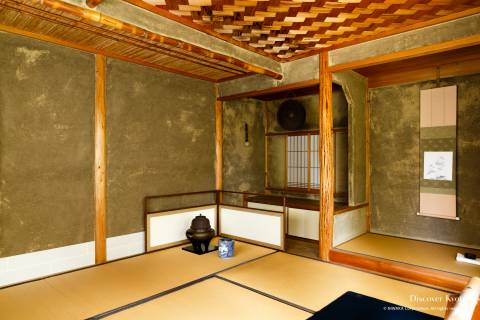Jikkō-in|実光院
Overview

Jikkō-in is a small temple located near the large Sanzen-in in Ōhara where visitors can enjoy a cup of green tea while looking out over a charming garden or taking a close look at instruments used in the shōmyō Buddhist chanting traditional in the area. The charming Keishin-en Garden features a pond and waterfall as well as “borrowed scenery” from the mountains across the valley, and also is home to a special type of sakura that blooms in autumn and lasts until spring.
Jikkō-in is a small temple located near the large Sanzen-in in Ōhara where visitors can enjoy a cup of green tea while looking out over a charming garden.
Features
Kyaku-den Guest Hall

The main hall for visitors is a perfect place to take a seat and enjoy the sight of the gardens on two sides of the open room, one with a lovely pond and waterfall, and the other features with the shakkei “borrowed scenery” from the nearby mountains. You can enjoy a cup of green tea and Japanese sweet here (included in the entrance fee) while taking in the sights, or explore the interior of the hall, in which many instruments used in shōmyō chanting are displayed. On the walls can be found various portraits and poems of the 36 Great Chinese Poets, and the principal images of the temple are enshrined within a small alcove altar. The Jizō Trinity consists of Jizō, protector of children and the lost, Bishamonten the Heavenly King of the North, and Fudō Myō’ō the Immovable Wisdom King.
Keishin-en Garden

Designed in the late Edo period, the Keishin-en garden (Garden of the Heart’s Vow) is most beautiful when viewed from the Guest Hall. On one side the garden features a small waterfall drawing from the nearby Ritsusen River and the Shinji Pond shaped like the character 心 for “heart” beneath an overhang of maple trees. The garden is full of symbolism, including a pine tree representing a crane and an island in the pond representing a turtle, two symbols of happiness and longevity. An arrangement of rocks also represents the Pure Land, where the Buddhist divinities dwell.
You can take a stroll through the garden as well, around a gourd-shaped pond, the Rikaku-an teahouse, and past fudanzakura, a special breed of cherry tree that starts blooming in autumn and not in March-April like most other types. This part of the garden is more recent, designed by the temple’s head priest. Both areas of the garden make lovely use of local wildflowers rather than relying on more showy, cultivated blooms, lending it a certain subtle elegance.
Green Tea

Since the cost is included in the entrance fee, you can take a seat in the Guest Hall to be served a freshly whipped cup of Japanese matcha (green tea) and a traditional wagashi sweet. Japanese tea ceremony encourages cultural appreciation, such as taking a good look at the bowl specially selected for the guest. There’s not much better than enjoying your tea while looking over such beautiful scenery, so don’t miss out!
Shōmyō Instruments

The general rule in temples is “look, but don’t touch”. However, in Jikkō-in you can actually feel free to inspect and try playing the shōmyō instruments on display – though please be gentle. Rows of bells of varying pitches that can be found on a black rack, as well as a lithophone (a sort of xylophone with stones for keys) provide particularly intriguing notes.
History
Jikkō-in was originally built as monk’s quarters known as Jikkō-bō, affiliated with the Tendai sect temple Shōrin-in revitalized by Jakugen in 1013. Jakugen, a ninth-generation disciple of Ennin (794-864) who brought the tradition of shōmyō Buddhist chanting from China, saw that the tradition spread through the area, and Jikkō-in is known for its connection to this style of religious music to this day. There are two styles of shōmyō represented in Japan today that greatly influenced Japanese music in general, Tendai and Shingon styles, and Ōhara is famous for its long history of advancing Tendai shōmyō.
Once located near the Ōhara mausoleums of Emperor Go-Toba and Emperor Juntoku, Jikkō-in was moved to its present location between Sanzen-in and Shōrin-in in 1919, and reconstruction was carried out in 1921.
Access
Address
〒601-1241 左京区大原勝林院町187
| TEL | 075-744-2537 |
| FAX | 075-744-2537 |
| WEB | http://www.jikkoin.com/ |
Admission
- General Admission: ¥700 (includes tea and a sweet)
- Primary School: ¥300
Hours
- General Admission: 09:00 – 16:00 (last entrance), entrance allowed until 16:30 in November
- Closed: No closing days
Transportation
- Kyoto City Bus ⇒ Route 17 ⇒ Ōhara Bus Stop ⇒ 15 minutes walking
Gallery
-




 +18
+18
